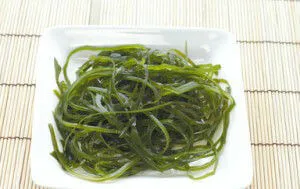If, like many Americans, you’re realizing benefits of staying away from processed carbs, you’re probably finding that there are now a wide variety of pasta alternatives. Here’s another option that is becoming more prevalent on supermarket shelves: kelp noodles.
Slightly crunchy, neutral in flavor and just bursting with nutritional benefits, kelp noodles are becoming a staple among raw-foodies and anyone looking for a low-calorie, gluten-free alternative to pasta.
To understand the true benefit of these hot new noodles, let’s start with a primer on kelp.
Kelp is a member of the brown algae family. It is an extremely concentrated source of iodine, which plays a key role in proper thyroid function, and is also a notable source of bioavailable iron.
Kelp contains a wide range of vitamins and minerals including calcium, magnesium, selenium and zinc, to name just a few. In short, you’ll have a hard time finding another source of such highly concentrated minerals in one food.
So, what are kelp noodles? Kelp noodles are made by extracting sodium alginate, a natural gum, from brown algae and then reapplying it to the kelp to form a “noodle.” Sodium alginate is used in many products on store shelves. It is a common thickening agent used in ice creams, salad dressings and chocolate milk.
A typical package of kelp noodles contains three four-ounce servings. Each serving contains a mere six calories, one gram of carbohydrate and no fat, cholesterol or sugar.
You can use kelp noodles in a variety of recipes. They can be eaten straight from the package, though they should be rinsed first since they have a slightly sea-like flavor. Their unique somewhat crunchy texture can be enjoyed in salads or as the main ingredient in pasta-inspired dishes. Cooking will soften the noodles so they are more reminiscent of noodles you have had before.
Kelp noodles have a neutral taste and will pick up whatever flavors they are marinated or cooked in. They work best with Asian-inspired dishes and sauces like ginger, sesame and Teriyaki, but also do quite well with traditional pasta sauces like marinara or pesto.
If you’re not a fan of the kelp noodle cousin, shirataki, kelp noodles may be a great alternative since the texture is quite different. In addition, soy-based shirataki products are on an upward trend – which you definitely want to stay away from given all the problems we have written about soy.
If you’re not sure what to do with kelp noodles, try some of these simpler recipes to get started, but don’t be afraid to experiment.
SIMPLE SEA VEGETABLE SALAD
- 1 clove garlic, grated
- ½ teaspoon grated fresh ginger
- ½ avocado
- ½ cup kelp noodles
- Tamari or gluten-free soy sauce, to taste
- Apple cider vinegar, to taste
- 2 cups greens (spring mix, buckwheat, spinach, lettuce)
- Sea salt and pepper, to taste
Grate the ginger and garlic into a small bowl. Mash the avocado into the ginger and garlic. Add the rest of the ingredients and toss together.

- kelp noodles
- Honey Mustard Dressing
- Cucumbers, sliced
- Carrots, sliced
- Apples, thinly sliced
- Sea salt, to taste
Combine all ingredients and mix well.
KELP NOODLE AND VEGETABLE STIR FRY
- 12 ounces kelp noodles
- ½ cup onion
- ½ cup bean sprouts
- ½ cup carrots
- ½ cup red bell pepper
- ½ cup mushrooms
- 1 tsp garlic, minced
- 1 Tbsp olive oil
- Tamari or gluten-free soy sauce, to taste
- Dash of coconut sugar
- Dash of sea salt and pepper
- ½ cup vegetable broth or water
Sautee the garlic in the olive oil. Add the vegetables and sautee until cooked. Add the rinsed kelp noodles along with the soy sauce, sugar, and broth and mix. Sautee until the noodles have softened. Add salt and pepper to taste.
-The Alternative Daily
Sources:
http://www.kelpnoodles.com
http://whfoods.org/genpage.php?tname=foodspice&dbid=135
